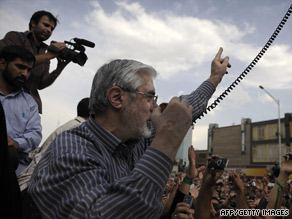
Supporters of opposition leader Mir Hossein Moussavi planned to turn Tehran into a sea of black Thursday when thousands of them march, dressed in dark clothes, to mourn comrades killed or wounded while calling for a new presidential election.
Demonstrators expected to start their rallies from mosques across the Iranian capital, converging in a city square Thursday afternoon, for what is expected to be one of the largest protests since last Friday’s disputed election. Moussavi, who has thus far appeared at one rally, said he will attend Thursday’s “ceremony of mourning.” On his Web site Wednesday, he asked his supporters to dress in black as a sign of respect for those who died or were wounded “as a result of illegal and violent clashes” with his opponents. The daily protests have claimed at least eight lives, according to Iran’s government-funded Press TV. Seven of those were protesters killed after they attacked a military post following a rally on Monday, the government said. The surging anti-government movement began soon after the results of Friday’s election coronated incumbent hard-liner, President Mahmoud Ahmadinejad, the winner by a huge margin. In the face of daily protests, the country’s election authority — the Guardian Council — agreed to recount votes in some areas. But Moussavi is asking for fresh elections, saying a recount will provide another opportunity for the government to manipulate the results. On Wednesday, his supporters took to the streets for a fifth day of protests, marching silently in 33-degree heat (91 degrees F) with tape over their mouths — perhaps as a way of keeping a low profile in the face of riot police, witnesses said. Watch protests Wednesday in Terhan » “The people of Iran are finally fed up with the lies, the temperament, the foolish actions of Ahmadinejad,” a 20-year-old Iranian man said.
Don’t Miss
Iranians get word out despite obstacles
Iranian protesters mostly unfazed by warnings
iReport.com: Los Angeles protest gets heated
Soccer team wears symbolic green bands
Wednesday’s rally ended without incident. But many Moussavi supporters in Iran and abroad feared that Ahmadinejad backers might try to mingle among the masses Thursday and start fights, offering an excuse for the police to move in and quash the demonstrations. Watch a quiet protest in Iran » There have been several incidents of violence, some of which Moussavi supporters blamed on Ahmadinejad backers and some on the Basij, a volunteer paramilitary force that takes orders from the government. Moussavi and former President Mohammad Khatami sent a letter asking Iran’s courts to quell post-election violence and release protesters who have been arrested. “The use of violence against ordinary people, raiding people’s residences just because they chant the sacred phrase of ‘Allahu Akbar’ (God is great), beating up women and men, destroying buildings” is not in line with the standards of the Islamic republic, the letter said. On Wednesday, Iran said it was investigating reports of violence at a Tehran University dormitory. See map of demonstration sites in Tehran » Though the focus of demonstrations has been in Tehran, reports of protests and violence sprouted in all corners of Iran. Human rights group Amnesty International, which is monitoring the situation through media reports and a network of local correspondents, said people had protested in Tabriz and Bobol in the north, Shiraz in the south and Mashad and Zahedan in the east. See galleries of protests in Iran » It reported several deaths in Oroumiye in the northwest and Shiraz, as well as beatings by police, use of tear gas and the detention of hundreds of protesters. Authorities in Tehran have cracked down on the protests by hauling dozens of demonstrators to jail and blocking access to social networking sites, such as Twitter and Facebook. Iran’s Revolutionary Guard Corps said it will pursue legal action against Web sites that it said were inciting people to riot. The Guard, a military unit that enforces the government’s Islamic codes and morality, blamed U.S., British and Canadian companies, including American intelligence agencies, for financially and technically supporting the Web sites. Iran’s government has also banned international journalists from filming the rallies, saying it could not guarantee the safety of reporters it has dubbed the “mouthpiece” for the “hooligans” behind the unrest. Still, residents found ways to get their message to the outside world using proxy servers. Their amateur videos and photographs began appearing on video-sharing sites, such as YouTube and CNN’s iReport. Watch how protesters use technology » The content was impossible to verify in most cases, and much of it was posted anonymously, some with little information. Still the images, showing protesters being beaten and bloodied, were jarring and powerful. Watch software that is assisting activists » Thousands of miles away, members of Iran’s national soccer team sported green arm and wrist bands Wednesday during their World Cup qualifying match against South Korea. The team does not normally wear bands of green, the venerated color of Islam that has been adopted by Moussavi supporters, and many Iranians viewed the gesture as a sign of support, though that has not been confirmed. Meanwhile, the Swiss ambassador to Iran — the representative of the United States in Iran — was called into the Iranian Foreign Ministry on Wednesday to hear complaints regarding U.S. interference in Iran’s election process, P.J. Crowley, assistant secretary of state for public affairs, told reporters in Washington. The United States does not have a diplomatic presence in Iran. U.S. President Obama has voiced “deep concerns” about the elections, as has the European Union. But neither has dismissed the election results. See timeline of recent Iranian history »
Counter-demonstrations by Ahmadinejad backers also have drawn thousands, reflecting a fissure in the country. Iran’s all-powerful leader, Ayatollah Ali Khamenei, has appealed to the citizenry to stand behind the Islamic republic. He is to deliver a sermon Friday that will be closely watched for a sign of how the government plans to resolve the stalemate.